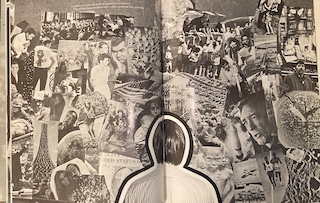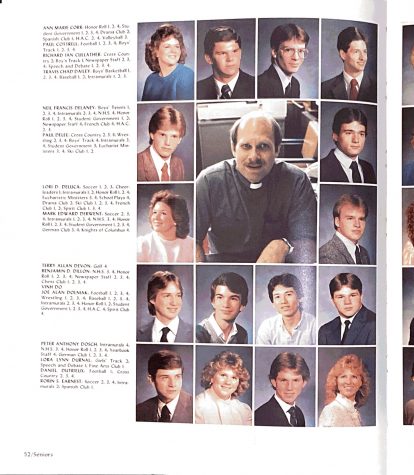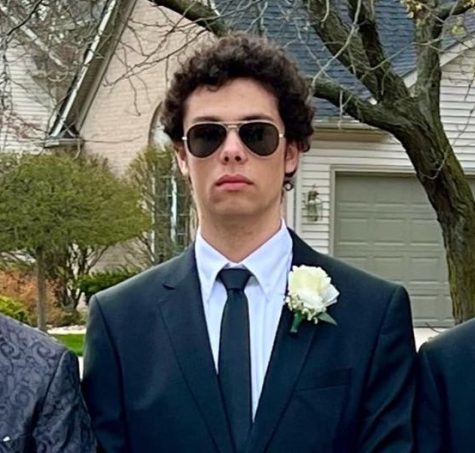Looking Back at St.Joe Yearbooks (Part 1)
October 21, 2020
Over the past decades, St.Joseph High School has undergone radical transformations, which may perhaps be best seen in the annual yearbooks of the various times. Yet much has stayed constant for our school over the years, with many images of the past looking like they could be from today, if not for clothing and hairstyles. Let’s take a look at some of these yearbooks, and what similarities and differences are seen with our own time.
At first glance, the 1956, 1970, and 1986 editions of the yearbook couldn’t be more different than our own. The 1956 cover has a slight mid-century modern flair, while the 1970 cover reeks of hippie aesthetic. 1986’s cover is a bit more subdued, but it’s faint script “eighty six” font is quite reminiscent of its time as well. Of course, another main difference of these past yearbooks and our present ones is the title, with “Hi-way” being used in the old building (as a reference to the building being off 933) and “The Avenue” being used since the move(Referring once again to the address of the school). Yet as we dive deeper into the yearbooks of the past, similarities are easily found.
Beginning with the 1956 edition, the differences in the school are quite evident from the get-go. Words are spoken of the brand, sparkling, new school building and how different this large school was for students coming from the recently merged schools forming Saint Joseph’s. These students got the chance to mix with many new people, despite classes not being this way–as these classes were separated by gender. The majority of teachers were priests and nuns, as seen by the several faculty pages kicking off the book. After this was the student pages, which look extremely similar to the 2020 edition’s format. Of the three yearbooks covered here, they are the only one to have senior quotes, although these seniors were not referencing the likes of Michael Scott. Dividing the pages are also the lyrics to the St.Joe fight song, another familiar component to today’s readers. However, the differences in the classroom are nothing compared to differences seen in athletics. Old fashioned-football helmets adorn St.Joe’s football team, while the basketball team looks closer to Hoosiers than to the teams of today. Girls sports received far less attention in these days, with their sports being listed under the Girls Athletic Association, and no varsity program appears in these pages.Other differences appear in the usage of school busing for many students, and massive changes in school uniforms. Yet much of St. Joe still looks familiar, with mass being held in the gym and announcements being relayed to the whole school, albeit over PA instead of video.

When opening the 1970 edition, the differences are far starker to our own time period. The yearbook opens with a poem discussing “a brave new world”, followed by a statement about how students may never have another chance to discover learning and accomplishment. This lack of optimism most likely can be attributed to the many challenges these classes had to face during the turbulent 1960s. Passages discuss doubt over the future of Catholic education due to a lack of funds and images of civil unrest and change are mixed in with traditional images of football players and cheerleaders. Certainly adding to this mood would’ve been the issue of the draft for the Vietnam War, which may have seen some students after graduation enlisted in the U.S Army. Yet similarities are still to be found throughout the yearbook, whether in a growing list of athletics and extracurriculars or in various dances and proms. One image notably has a sign to “keep the lounge clean” or it will be closed–the same issue that struck our Commons last year. Even the civil rights and environmental concerns call to mind 2020’s own issues. At first glance, this edition seems to be far removed from our own time, but perhaps we are more closely linked than originally perceived.

The 1986 edition is by far the most similar to our own time out of these three yearbooks. Athletic uniforms don’t look too ancient. Students are said to work at Taco Bell and Martins. Even familiar names like Mr. Dillon and Mr. Oross grace the pages, albeit in student form. Many extracurriculars absent from the 56’ and 70’ books appear here, such as girls’ basketball, hockey, and soccer. Yet this was unmistakably a product of the decade. Passages reference stars of the MTV generation, such as A-Ha and Whitney Houston. Others discuss the new preppy style taking over at the time, as evidenced by many of the pictures throughout the book. The individual images of students display their age as well, as the now-colored images show exactly the big hair and big style of the decade. At the end of the day, however, the Saint Joseph’s High School of 1986 looks almost identical to the Saint Joseph of today. An 80s themed spirit week day would pretty much achieve a mirror image of this time, just in a newer building. (The introduction actually mentions the evident age of the building, despite continuing to be used for over two decades more). If the 1970 edition was similar to today due to outside events, the 86’ edition is similar because of what actually occurred in the building.

Overall, looking back at old St. Joseph yearbooks makes one wonder how different the generations are. On the surface, much has changed, but the core high school experience is something that unites many, regardless of age. In the next installment of this series, we’ll take a look at some more relatively modern editions of the annual yearbook, and continue to compare it to our own.

